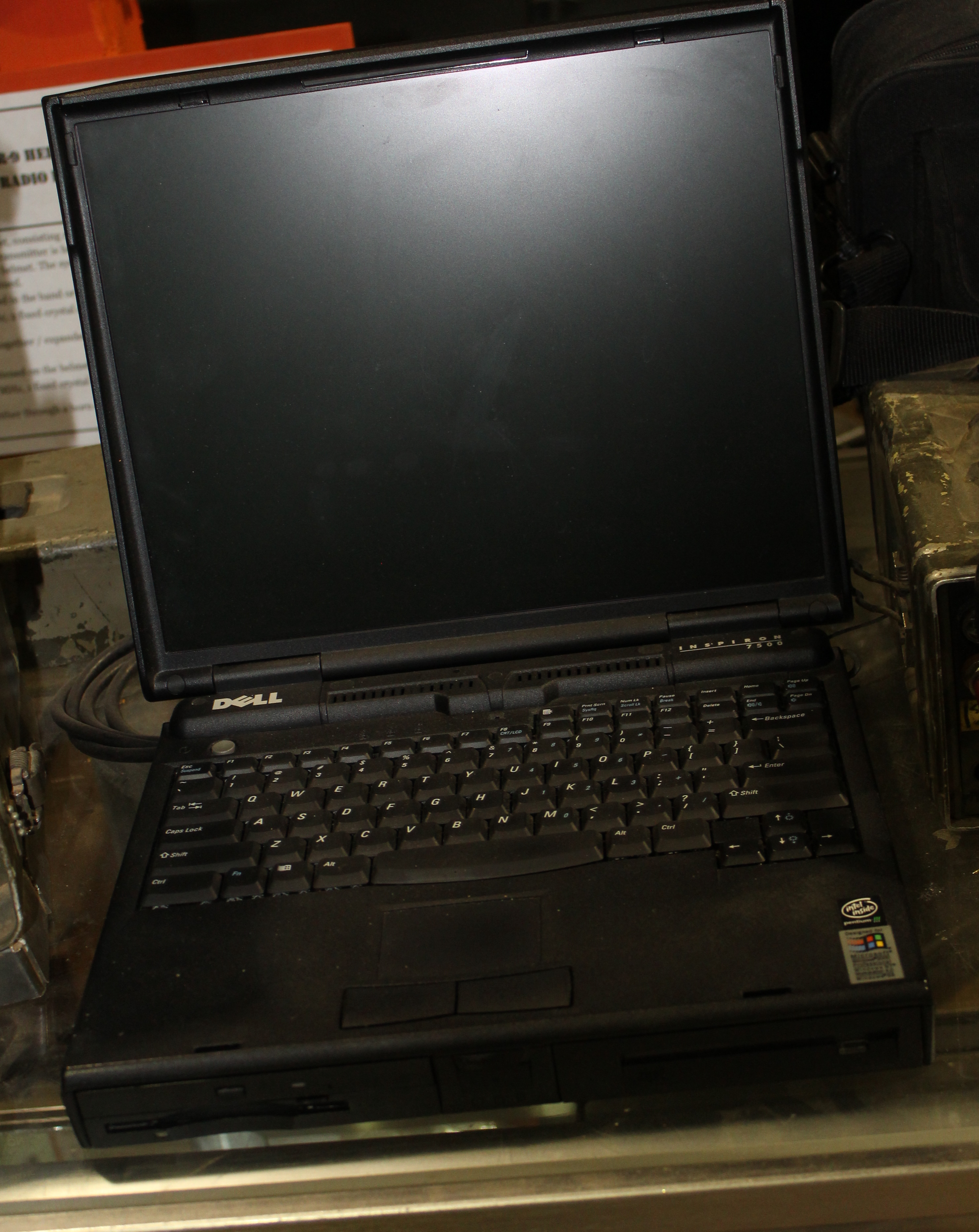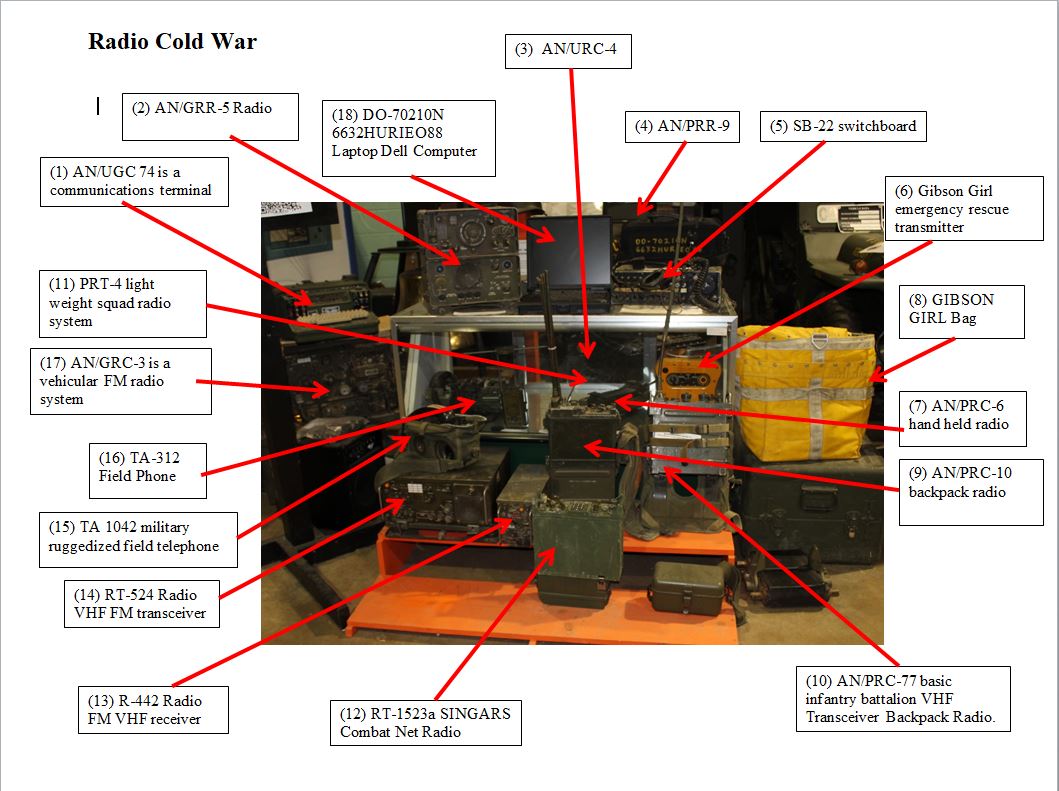(1) The AN/UGC 74 is a communications terminal used for composing, editing, transmitting, receiving and printing messages. The AN/UGC 74 is very rugged and built for adverse conditions. The circuitry inside the terminal is shielded against electromagnetic damage. These were produced for the US government for almost $10,000 each and weigh almost 100 pounds. ( Cold War Radio Display )

The AN/UGC 74 is a message communications terminal used to compose, edit, store, transmit, receive and print army record traffic communications. The AN/UGC 74 will interoperate with post 1980 COMSEC communications equipment. The terminal uses Baudot or ASCii serial data. The terminal can operate in synchronous or asynchronous mode using various data rates. The UGC 74 can operate on 110 or 220 volts ac and requires about 100 watts of power. The AN/UGC 74 is very rugged and built for adverse conditions. The circuitry inside the terminal is shielded against damage from electromagnetic damage. These were produced for the US government for almost $10,000 each and weigh almost 100 pounds. The AN/GRC-74B terminal is part of a communications system referred to as the AN/GRC-122.
(2) The AN/GRR-5 Radio, sometimes referred to as the "Angry-5" is a 1950's era compact mobile shortwave radio receiver. The radio operates on AM, CW and Single Side Band (SSB) in a frequency range from 1.5 to 18 megahertz. These radios were originally intended to receive warnings for gas, nuclear and biological attacks. ( Cold War Radio Display )

The AN/GRR-5 radio system is a 1950's era shortwave radio receiver operating from 1.5 to 18 megahertz. The system has two modules: the upper unit is the R-174 URR receiver and the lower unit contains the PP-308 URR power supply, power adapters and the speaker. The two units are housed together in a cabinet. This radio was used by the US military in the 1950's and 60's. The primary purpose of the radio was to serve as a warning receiver for gas, nuclear and biological weapons attacks. The large dial on the upper unit is the tuning knob. The receiver also has frequency presets. The radio is built using low voltage miniature tubes and can be powered from several different sources. The radio has inputs for 110 volts AC, or 6,12, and 24 volts DC. During the time period when these radios were manufactured, they cost the government over $800 per unit. The radio can operate on AM,CW (morse code) and SSB (single side band) communications modes.
(3) The AN/URC-4 is an Air-Sea Rescue Radio issued to aircraft during the Korean and Vietnam wars. The radio was designed to operate on standard VHF and UHF emergency frequencies and enabled downed pilots and personnel to signal rescue aircraft. The radio utilized an external battery and had a range of about 100 miles. ( Cold War Radio Display )

The AN/URC-4 is a US made, short range, Air-Sea Rescue Radio. The URC-4 operated on VHF at 131 Megahertz and UHF at 243 Megahertz. These two frequencies are still used today for emergency communications. The URC-4 contains a transmitter and receiver. The transmitter generates about 35 watts of output power. High altitude aircraft could pick up the URC-4's signal from 100 miles away. The URC-4 contains a horizontal dipole antenna which has two positions for its VHF and UHF operating frequencies. A band switch on the side of the radio sets the frequency. The radio is powered by an external power source connected by a short cable providing 1.3 volts and 136 volts. These radios were first issued in the 1950's and were placed on almost every aircraft during the Korean and Vietnam wars. The URC-4 operated in Receive mode, Transmit mode (voice) and Transmit mode (tone). Tone mode generated a continuous tone which could be used as a homing beacon for Aircraft. The Strategic Air Command operated C-47s with directional antennas specifically for this purpose.
Trivia: Francis Gary Powers had a URC-4 Rescue Radio in his U2 Reconnaissance Plane when it was shot down over the former Soviet Union.
(4) The AN/PRR-9 is a compact radio receiver designed to operate with the AN/PRT-4. When used together these radios provided enhanced communications capability for small infantry units superior to communications via hand signals. The squad leader carried and operated the PRT-4 transmitter. Members of the squad would carry the PRR-9 in order to receive instructions from the squad leader. The radio is small enough to be mounted on a helmet. ( Cold War Radio Display )
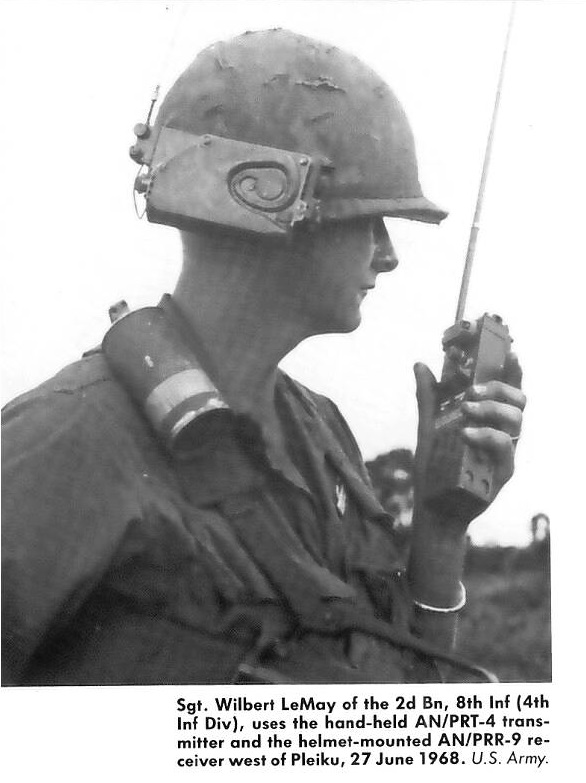
The PRR-9 is a compact radio receiver designed to operate with the AN/PRT-4 transmitter. Together, these radios provided small infantry units the ability to communicate when separated by distances where use of hand signals is not possible. The squad leader carried the PRT-4 transmitter and used this radio to issue commands to elements of the squad equipped with the PRR-9. A limitation of this system is that the squad elements possessing the PRR-9 could not respond to received instructions, but could only monitor the squad leader. The PRR-9 and PRT-4 were first used in Vietnam in 1967. The receiver could be carried on web gear or mounted on a helmet. These radios operated on two channels located in the frequency range between 47 and 57 megahertz. The range of reception for the PRR-9 was between 500-1600 meters. One drawback of the PRR-9, when the radio was worn on the helmet, was that the antennas were frequently damaged when traveling through underbrush. When carried on web gear, the radios did not perform as well since the helmet served partially as a ground for the radio. Like the PRT-4 the PRR-9 was made by Delco. These radios operate on FM and provide excellent sound quality adequate to allow whispering by the squad leader. One weakness of the design of both the receiver and transmitter is that the batteries were not protected by an enclosure and were sometimes damaged or degraded by exposure to the elements. These radios were eventually replaced by the PRC-25.
(5) The SB-22 is a small portable switchboard for field telephone systems. The SB-22 contains 12 individual line units. Circuit connections are configured in the SB-22 using patch cords. The capacity of a single SB-22 system can be augmented by patching multiple switch units. Most military phones that use magneto signalling are compatible with the SB-22 including the EE-8, and the TA-312.

The SB-22 is a small portable switchboard for field telephone systems. The SB-22 contains 12 individual line units. Circuit connections are configured in the SB-22 using patch cords. The capacity of a single SB-22 system can be augmented by patching multiple switch units. The SB-22 is designed to operate in Local Battery Mode in which phone connected to the system generate their own ringing signal instead of using power from the switch. The SB-22 has 12 line packs and a single operator pack. The SB-22 is powered by 4 D cells which provide power for the operators headset, and the night alarm light and buzzer. Most military phones that use magneto signalling are compatible with the SB-22 including the EE-8, and the TA-312.
(6) The "Gibson Girl" is an emergency rescue transmitter intended to be used by downed aircraft crews to broadcast a distress signal. The radio was powered by a hand-crank generator. The radio kit included a hydrogen generator, a kite, a 300 ft long-wire antenna and a balloon to hold the antenna aloft. The radio operated at 500 khz and generated the distress signal in Morse Code automatically when the handle was turned. ( Cold War Radio Display )
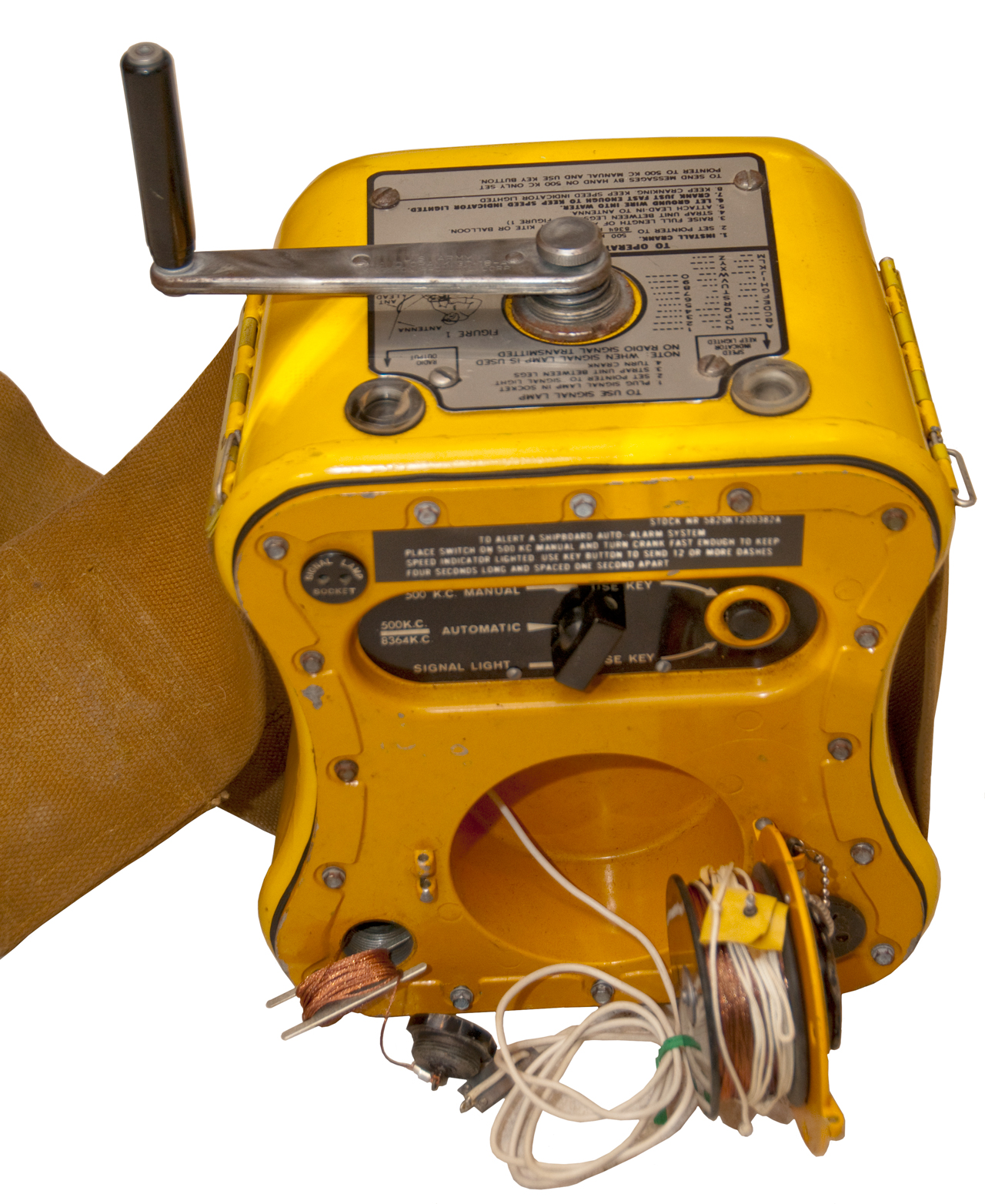
The "Gibson Girl" is an emergency transmitter designed to be used by stranded air-crews after having ditched in the ocean. The name "Gibson Girl" was inspired the the distinctive hour-glass shape which allowed the operator to hold the radio firmly with their legs while turning the crank. The radio was powered by the hand crank and used a 300 ft long wire antenna held aloft by a kite and a balloon filled with a hydrogen generator included in the kit. The Gibson Girl transmitter operated at 500 khz and produced an output power of almost 5 watts giving it a theoretical range of about 200 miles. The radio was designed to transmit a distress signal automatically when the generator handle was turned. The design of the Gibson Girl was inspired by the German made Notsender Radio produced for similar applications. The American Gibson Girl radios were initially produced by Bendix Aviation Limited. In 1942, 11,600 Gibson Girl sets were ordered by the US military. The radio was painted bright yellow and came packaged in a yellow canvas bag. The radio could be dropped by parachute but was usually tossed into the ocean from the ditched aircraft. The nominal turning speed required for the hand-crank generator was 80 RPM. In addition to its function as a transmitter, the radio could also be used as a hand-powered signal light for use when rescue craft were approaching. The Gibson Girl was in use into the late 1970's.
(7) The AN/PRC-6 is a small hand held radio used in the Korean and Vietnam wars. The PRC-6 was developed by Raytheon and was a replacement for the earlier SCR 536 radio. The AN/PRC-6 operates on a single crystal in the 47-55 megahertz frequency band. This radio was used by the Marine Corps as late as 1972. ( Cold War Radio Display )

The AN/PRC-6 is a small hand held radio used in the Korean and Vietnam wars. The PRC-6 was developed by Raytheon and was a replacement for the earlier SCR 536 radio. The AN/PRC-6 operates on a single crystal in the 47-55 megahertz frequency band. This radio was used by the Marine Corps as late as 1972. The PRC-6 contains a transmitter and receiver and utilizes thirteen sub miniature vacuum tubes. The PRC-6 uses a 24 inch whip antenna and can also use a direction-finding loop antenna. Power output is 250 milliwatts. Maximum range is about 1 mile in ideal line-of-sight conditions. The PRC-6 was used by forward elements of infantry, armored and artillery units. The PRC-6 is powered by 1.5, 4.5, 45 and 90 volt batteries.
(8) GIBSON GIRL Bag ( Cold War Radio Display )

This is the bag that the AN/CRT-3 GIBSON GIRL radio was stored in.
(9) The AN/PRC-10 backpack radio was first introduced into service with the US military in 1951. The PRC-10 is one of a family of similar radios including the PRC-8 and PRC-9. The PRC-10 is a superheterodyne transceiver with a transmitter and receiver in one chassis sharing a single antenna. ( Cold War Radio Display )
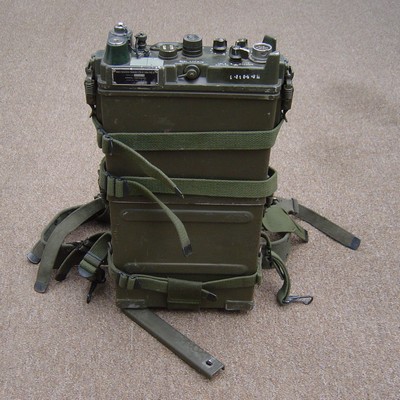
The AN/PRC-10 backpack radio was first introduced into service with the US military in 1951. The PRC-10 is one of a family of similar radios including the PRC-8 and PRC-9 which are nearly identical but operate on different frequencies. The PRC-10 is a superheterodyne transceiver with a transmitter and receiver in one chassis sharing a single antenna. The radio is housed in a magnesium water tight case. The PRC-10 is powered by an external battery unit, the BA-279. An adapter was also provided for the radio that could allow it to be powered by a vehicle electrical system. The PRC-10 operated on 38 - 55 megahertz and utilized 16 vacuum tubes. The PRC-10 antenna is 10 ft long and can be folded when the radio is carried. The radio is also designed to use a short antenna 3 ft long made of flexible steel tape riveted together. Soldiers carrying the PRC-10 found that the 10 ft tall antenna identified them as a target of value to the enemy. For this reason, the radio was frequently operated with the short antenna and sometimes carried upside down with the antenna pointed down. The PRC-10 had a maximum range of 12 miles. This radio remained in service until the mid-1960's. The weight of the radio including batteries was 26 pounds. For operation, the radio required 1.5, 6, 67.5 and 135 volts. The unit could operate 20-30 hours when powered by the battery unit.
(10) The AN/PRC-77 is a basic infantry battalion VHF Transceiver Backpack Radio. The AN/PRC-77 is the successor to the AN/PRC-25 radio and was introduced by the US Army in 1968. The AN/PRC-77 was heavily used during the Vietnam War. ( Cold War Radio Display )

The AN/PRC-77 is a military VHF Transceiver Backpack Radio. The AN/PRC-77 is the successor to the AN/PRC-25 radio and was introduced by the US Army in 1968. The AN/PRC-77 was heavily used during the Vietnam War. The transceiver operates on the 30-75.5 megahertz frequency range. The Transmitter can generate about 2 watts of output power giving the radio a range of about 5 miles. The radio can be powered by internal batteries or an external power source such as the battery of a vehicle. The AN/PRC-77 operates on two bands: 30-52.950 megahertz and 53-75.950 megahertz. The two dials in the center of the radio are used to set coarse and fine tuning. The AN/PRC-77 can be used with an external encryption unit, the KY-38, which is almost the size of the radio itself, to provide high-end encryption for voice transmissions. The AN/PRC-77 has been replaced by more modern SINCGARS radios but is still interoperable with VHF FM radios used by the US military. The AN/PRC-77 is designed to be service-friendly and field repairable. The radio is contained in a water-tight enclosure that can be removed by loosening four bolts. Total weight of the radio is about 12 pounds.

(11) The PRT-4 is part of a light weight squad radio system. It was first fielded in Vietnam by the US Army in 1967. The PRT-4 transmitter was used in combination with the PRR-9 receiver which are two separate radios. The transmitter was carried by the squad leader and was used to transmit messages to squad elements equipped with the PRR-9 receiver. ( Cold War Radio Display )

The PRT-4 is a small light weight radio transmitter designed to operate with the PRR-9 receiver. Together, the transmitter and receiver were intended to provide a communications link for squad elements superior to hand signals. The squad leader carried the PRT-4 transmitter and squad members carried the PRR-9 receiver. This radio system was intended to replace the Korean War era PRC-6 radio which was deemed cumbersome and heavy. A limitation of this system is that it provided one-way communications only. The squad leader could issue commands to the squad elements equipped with the receiver, but they could not respond to the messages. The PRT-4 and PRR-9 were crystal controlled and operated on FM at frequencies 47 - 57 megahertz and had a range of about one mile. The PRT-4 had a maximum power output of 450 milliwatts. The PRT-4 was manufactured by the Delco Division of General Motors Corporation. The antenna for the radio was a telescoping whip 24 inches long with a black oxide coating. The PRT-4 is the first US military field radio to use an integrated circuit in its design. The radio was configured to use an externally connected battery set which was vulnerable to damage from exposure to the elements. The antenna was also frequently broken when carried in jungle terrain.

(12) The RT-1523a Radio Transceiver is a SINGARS Combat Net Radio currently used by US and Allied military forces. SINGARS (Single Channel Ground and Airborne Radio System) is a new radio technology which is a generation beyond the former Vietnam era single-frequency radios such as the AN/PRC-77. The primary purpose of the RT-1523 SINGARS Radio is to provide secure voice and data communications between air and ground assets. ( Cold War Radio Display )

The RT-1523 SINGARS Radio is a modern era military Combat Net Radio designed to provide secure ground to air voice and data communications. SINGARS is a new technology standard for military radios that replaces the earlier Vietnam era PRC radio sets. The SINGARS concept emerged in 1983 and its design evolution continues today. Several large, well known technology firms have contributed to it's development such as Harris, ITT and General Dynamics Corporation. These radios are intended to fill several roles including installation in vehicles, aircraft, and field portable man-pack versions. The SINCARS radios can operate in single channel mode or frequency hoping mode. In single channel mode, the RT-1523 can interoperate with previous version PRC VHF FM radios. The SINGARS radio operates on 2320 channels over a frequency range of 30-88 megahertz. In Frequency Hoping mode, the SINCARS can change frequencies 100 times per second to prevent jamming and direction finding. The 1523a radio supports COMSEC encryption using optional system cards. RT-1523 can be equipped with a GPS module to provide position reporting. The RT1523 has the ability to select output power which varies the range of the radio from 1000 ft to 5 miles. An external amplifier can be added which extends the range of the radio to 22 miles. The radio is generally operated with the minimum power level necessary in order to minimize it's electronic footprint. The RT1523 can operate with broadband antennas such as the OE-254 ground-plane or AS-3900 vehicular whip antennas. In 2008, the SINCGARS radio technology was superseded by the JTRS Joint Tactical Radio System based on Software Defined Radio technology. The RT-1523 can operate on 12 volts for man-portable operation, or 24 volts DC for vehicular operation.
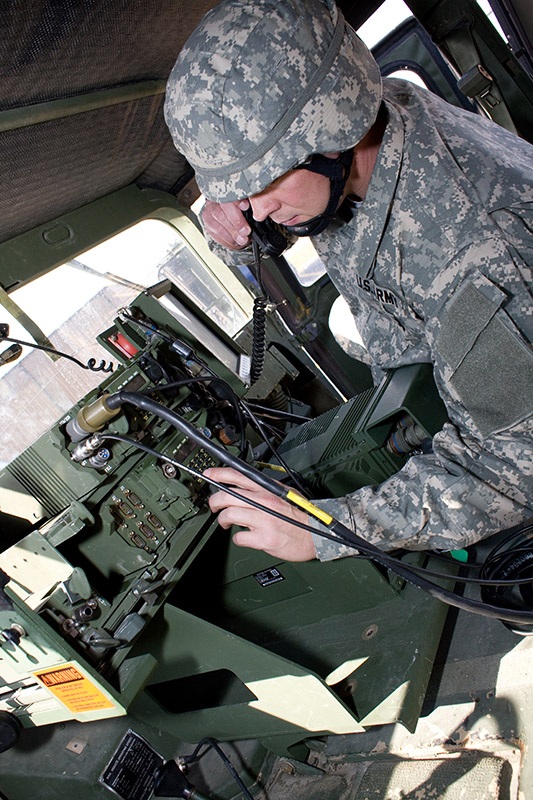
(13) The R-442 Radio is an FM VHF receiver that operates on the frequency range 30-76 megahertz. The R 442 is a component of a vehicular radio system typically installed in M151 jeeps, Humvees and some tanks. The radio can operate as a stand-alone receiver or in a system paired with the RT-524 transmitter. ( Cold War Radio Display )

The R442 Radio Receiver is an FM VHF receiver introduced in 1963 and used in the Vietnam War and Desert Storm. The R442 was the receiver component of the AN/VRC-12 Radio System developed by Avco Corporation. This system is the successor to the AN/GRC-3 Radio System and was itself later replaced by the SINCGARS Radio System of the 1990s. The R442 operated on the frequency range 30-76 megahertz. The R442 was superheterodyne and crystal controlled. The unit weighs about 18 pounds and operates on 24-28 volts DC and requires .75 amps. This radio is compatible with the AN/PRC-25 and AN/PRC-77.
(14) The RT-524 Radio is a VHF FM transceiver usually installed in vehicles. This radio was a component in the AN/VRC-47 Radio System used in M151 Jeeps, older Humvees and some tanks. The AN/VRC-47 Radio system also used the R442 Receiver. ( Cold War Radio Display )
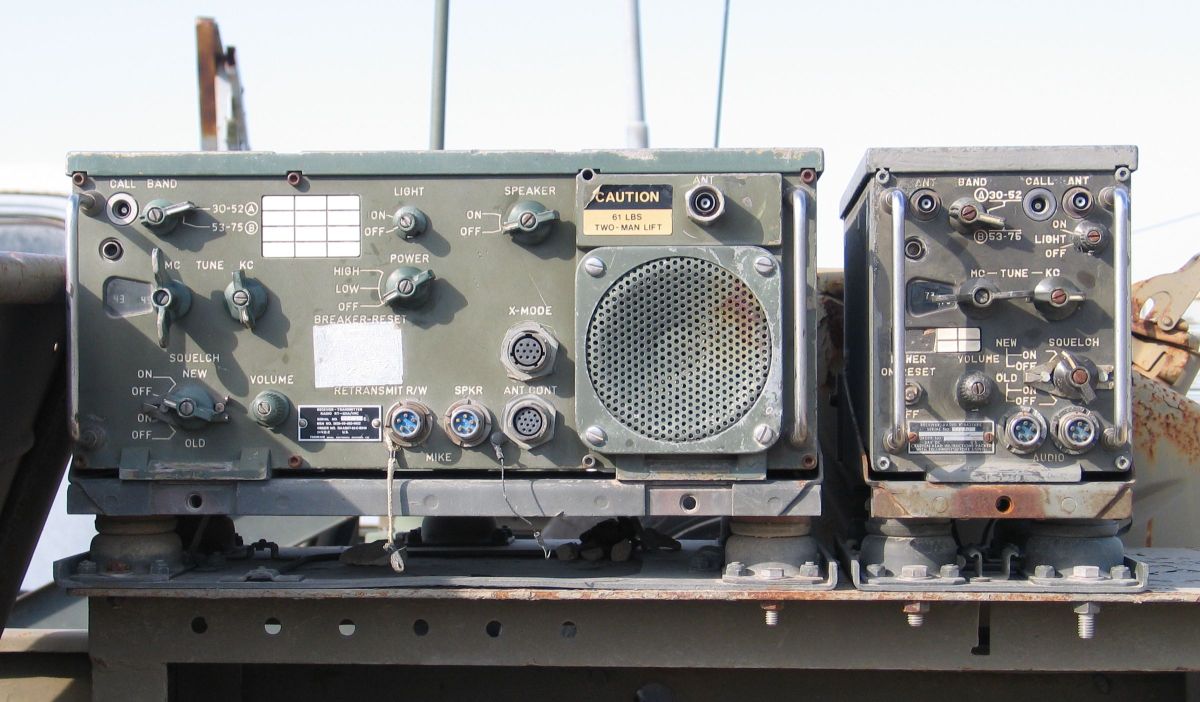
The RT-524 Radio is a VHF FM transceiver that operates on the frequency range 30-75 megahertz. This radio was typically installed in vehicles and was used during the Vietnam War and Desert Storm. The RT-524 has a reputation for combat proven rugged reliability. The radio operates on 24-28 volts DC vehicular power and has an internal speaker. The RT-524 has a noise operated squelch and an advanced tone-operated squelch for use in an automatic relay station. The transmitter can generate 35 watts of output power. This radio is superheterodyne and crystal controlled. It weighs 58 pounds.

This is the radio set AN/VRC-47 which includes the RT-524 and the R442 radios:
(15) The TA 1042 is a military ruggedized field telephone. It is used as a table-top device in tents, shelters and offices. It can also be operated outdoors mounted on trees or poles. The TA1042 is classified as a Digital Non-Secure Voice Terminal. The construction of the TA1042 is very sturdy which allows it to survive rough handling during transport and operation in the field.

The TA 1042 is a military ruggedized field telephone. It is used as a table-top device in tents, shelters and offices. It can also be operated outdoors mounted on trees or poles. The TA1042 is classified as a Digital Non-Secure Voice Terminal. The construction of the TA1042 is very sturdy which allows it to survive rough handling during transport and operation in the field. The TA1042 also has a 55-pin Digital Data Port for connection to external devices such as FAX. This field phone is a non-secure telephone and has no capability to encrypt communications. However, voice is digitized by this phone and sent along with signalling information full-duplex in 16 or 32 kilobyte baud rates. The TA1042 operates in both common-battery mode and local battery point-to-point mode. In point-to-point mode, two TA1042 field phones can connect directly without using a switch. When connected to a switch, the phone uses loop-signalling to interact with other phones in the system.
(16) The TA-312 Field Phone is an analog, two-wire battery operated telephone used for military communications. The TA-312 operates over a two wire cable often strung in battlefield conditions. The TA 312 Field Phone was used during the 1950's, through the Korean War, the Vietnam war and into the 1980's. The TA 312 Field Phone was known to be very rugged and reliable. ( Cold War Radio Display )

The TA 312 Field Phone is an analog, two wire, battery operated field phone used by the US military and its allies in the 1950's through the 1980's. The TA 312 was successor to the EE-8 Field Phone used during World War Two. The TA 312 can be used in any point-to-point two wire analog voice circuit and can also be connected to a Plain Old Telephone Service network (POTS) using a DTMF keypad. The TA 312, when operating in Local Battery mode uses two "D" cells. This phone can also operate in Common Battery mode in which case it uses battery voltage provided by the switchboard. The operating range was typically about 20 miles. The TA 312 can interoperate with the SB-22 switchboard. The built in hand crank generator is used to create an outgoing ring signal.
(17) The AN/GRC-3 is a vehicular FM radio system operating on the frequency range 20-55 megahertz. The AN/GRC series 3,4,5,6,7 and 8 radio sets are intended to be installed in trucks, armored personnel carriers, tanks, weapons carriers, and other armored vehicles. These radios are designed to provide short range communications between artillery, infantry and armored units. The AN/GRC-3 is specifically designed for use in armored vehicles. ( Cold War Radio Display )

The AN/GRC-3 is an FM radio system produced in the 1950's, designed to provide short range communications for armored vehicles. The GRC-3 operates on the frequency range 20-55 megahertz. The AN/GRC-3 system contains multiple sub-units including the RT-66 transmitter-receiver, RT-70 transmitter-receiver, R108 receiver, PP112 power supply, and various control boxes, cables, antenna masts, and adapters. The RT-70 transmitter-receiver is used for liaison between divisions and is included in all of the GRC-3 through 8 systems. The communications range is about 10 miles. The system's transmitter output is about 16 watts. When transmitting, the system requires 12 amps at 24 volts DC. The AN/GRC-3 was installed in M4 medium tanks, the M8 light armored car, the M37 cargo truck, and the M24 light tank. The entire system is bolted to a mounting bracket inside the vehicle and is powered from the vehicle battery using the system's power adapters. The power adapters contain vibrator type power circuits which generate plate,screen and bias voltages.

(18) DO-70210N 6632HURIEO88 Laptop Dell Computer NSN 7021-01-C01-5084:MICRO LAPTOP PORTABLE AC/DC W/ BATTERY PK: D600 DELL This computer was issued to U.S. Army personnel in the 1990s. The computer was hardened for use in the field.
